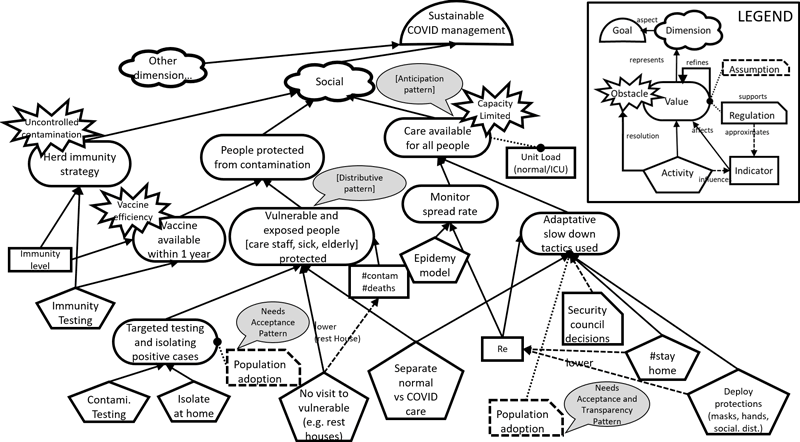by Christophe Ponsard and Bérengère Nihoul (CETIC)
The design sustainable systems requires to explore and combine multiple facets relating to the dimensions of society, economics and the environment. To analyse COVID-19 pandemic management strategies from a fairness perspective, we used a sustainability modelling framework together with a pattern library focusing on fairness. This helps with the analysis of strategic decision making and provides guidance for a successful adoption of measures.
Inherent in the concept of sustainability is the idea of “fairness” in terms of resource allocation among actors involved in a system. To achieve a balanced design it is necessary to set some constraints on the way systems are designed. A “balanced design” does not imply pure formal equality, which in practice is unachievable, but rather a global equilibrium based on core values such as solidarity. In our work, we are trying to determine how different aspects of fairness can be identified and managed in complex systems composed of different kinds of users, stakeholders and software that needs to deal with related rules.
Reasoning on such systems requires that, in addition to the above dimensions, we need to capture key organisational concepts, such as goals/barriers, values, activities, regulations, and indicators. These can be organised in multi-perspective sustainability models [1]. Specific model patterns can be identified to enable the reuse of proven designs with their context and some guidelines [2]. From the literature and our experience in designing healthcare and shared transport systems, we identified fairness patterns such as rule adoption and acceptance, distributive justice[L1], violation anticipation and transparency [3].

Figure 1: Sustainability analysis of pandemic management focusing on the social dimension.
The COVID-19 pandemic provided a rich case study to experiment and enrich our approach and pattern library. Figure 1 depicts a sustainability analysis of pandemic management focusing on the social dimension. Values are depicted using ovals and their barriers using explosion labels. For example, the herd immunity strategy is discarded because too risky. The longer-term vaccine strategy is not detailed to focus on shorter-term protection actions. Different patterns were applied during the analysis and are tagged using grey balloons:
- a distributive justice pattern is used for protecting vulnerable community members;
- an acceptance pattern is also identified to implement the assumption that all people will adopt safe behaviours to protect the vulnerable as called for by authorities [L2];
- an anticipation pattern is used to make sure care will stay available. It results in a balance between monitoring (using indicators such as Re) and lockdown level that can ensure the contamination curve is flattened;
- rule acceptance and transparency patterns are also useful to ensure that people adhere to confinement rules.
So far, our framework has proved very interesting for analysing and reasoning on complex systems such as COVID-19 management, especially when scaling it up to other dimensions so that it covers environmental (e.g. waste due to overpacking, the use of disposable masks) and economic issues (e.g. temporary unemployment benefits). In our future work, we plan to adapt the KAOS/ Objectiver goal-oriented requirements engineering tools to support our notations and capture our patterns through the existing library mechanism [L3].
Links:
[L1] https://www.beyondintractability.org/essay/distributive_justice
[L2] http://bit.do/covid-call-for-fairness
[L3] http://www.objectiver.com
References:
[1] J. Kienzle and al., Toward model-driven sustainability evaluation. Comm. ACM 63(3), 2020.
[2] K. Roher and D. Richardson, Sustainability requirement patterns, in 3rd Int. Workshop RePa, 2013.
[3] C. Ponsard and R. De Landtsheer, Dealing with scheduling fairness in local search: Lessons learned from case studies, in Revised Selected Papers ICORES 2018.
Please contact:
Christophe Ponsard, CETIC, Belgium











